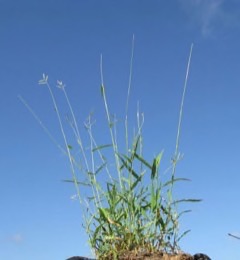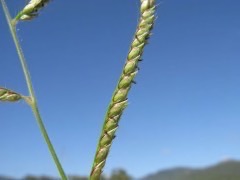 |
|
Wikimedia.org - Harry Rose from Dungog, Australia |
 |
| Wikimedia.org - Harry Rose from Dungog, Australia |
Translate this page:
Summary
Physical Characteristics

 Urochloa mosambicensis is a PERENNIAL growing to 1.2 m (4ft) by 0.1 m (0ft 4in) at a fast rate.
Urochloa mosambicensis is a PERENNIAL growing to 1.2 m (4ft) by 0.1 m (0ft 4in) at a fast rate.
See above for USDA hardiness. It is hardy to UK zone 10. The flowers are pollinated by Apomictic (reproduce by seeds formed without sexual fusion). The plant is self-fertile.
Suitable for: light (sandy), medium (loamy) and heavy (clay) soils, prefers well-drained soil and can grow in nutritionally poor soil. Suitable pH: mildly acid, neutral and basic (mildly alkaline) soils and can grow in very acid, very alkaline and saline soils.
It can grow in semi-shade (light woodland) or no shade. It prefers moist soil and can tolerate drought. The plant can tolerates strong winds but not maritime exposure.
UK Hardiness Map
US Hardiness Map
Synonyms
Brachiaria stolonifera Gooss. Echinochloa notabilis (Hook.f.) D.Rhind Panicum mosambicense Hack. Panicum notabile Hook.f. Urochloa pullulans Stapf Urochloa rhodesiensis Stent Urochloa stolonifera (Gooss.) Chippind.
Plant Habitats
Edible Uses
Edible Parts: Seed
Edible Uses:
Seed - cooked. It is used as a cereal, usually being ground into a flour which is then often eaten as a porridge[299 ].
References More on Edible Uses
Medicinal Uses
Plants For A Future can not take any responsibility for any adverse effects from the use of plants. Always seek advice from a professional before using a plant medicinally.
None known
References More on Medicinal Uses
The Bookshop: Edible Plant Books
Our Latest books on Perennial Plants For Food Forests and Permaculture Gardens in paperback or digital formats.

Edible Tropical Plants
Food Forest Plants for Hotter Conditions: 250+ Plants For Tropical Food Forests & Permaculture Gardens.
More

Edible Temperate Plants
Plants for Your Food Forest: 500 Plants for Temperate Food Forests & Permaculture Gardens.
More

More Books
PFAF have eight books available in paperback and digital formats. Browse the shop for more information.
Shop Now
Other Uses
Agroforestry Uses: It is an effective plant for erosion control, and for other applications where rapid establishment and good ground cover are advantageous[299 , 415 ]. In Australia it plays a role in mine site rehabilitation[299 ]. Urochloa mosambicensis does well in intercropping with leguminous pasture plants and is commonly grown together with Stylosanthes spp[299 ].
Special Uses
Carbon Farming
References More on Other Uses
Cultivation details
Management: Standard Staple Crop: Balanced carb Wild Staple Crop
In its natural habitat Urochloa mosambicensis occurs at elevations up to 1,600 metres in regions with a mean annual rainfall of 400 - 1,200mm, exceptionally to 1,600mm, and a dry season of 5 - 9 months[299 , 305 ]. Plants have tolerated light frosts, but are checked by anything more than this[375 ]. Prefers a sunny position, but tolerates light shade[415 ]. It will grow in a wide range of soils, from clay loams to sands, but appears to be more suitable for lighter soils with relatively high fertility[299 , 305 ]. It can tolerate both acid and alkaline soils[305 ]. Established plants are drought tolerant[305 ]. Tolerates lower fertility than most sown grasses with some salinity tolerance. In northern Australia the plant has escaped from cultivation and becomes dominant after fires[299 , 305 ].However, the plant is considered to be too palatable and insufficiently aggressive to become a serious weed[415 ]. The seeds germinate early in the wet season and vegetative growth continues until soil water is exhausted. Flowering starts 3 - 4 weeks after the start of the rainy season and continues until growth ceases. Seed matures in 3 - 4 weeks[299 ]. Plants are often short-lived, dying after 3 - 4 years[299 ]. Urochloa mosambicensis is an obligate apomict[299 ]. The plant follows the C4 photosynthetic pathway[299 ]. To obtain the grain, the inflorescences are picked when still slightly green and spread out in the sun to dry. When dry, the grains are easily rubbed from the stalks[299 ]. Annual grain yields of 100 - 300 kilos per hectare have been recorded from Australia[299 ].
Carbon Farming
-
Management: Standard
Plants grow to their standard height. Harvest fruit, seeds, or other products. Non-Destructive management systems.
-
Staple Crop: Balanced carb
(0-15 percent protein, 0-15 percent oil, with at least one over 5 percent). The carbohydrates are from either starch or sugar. Annuals include maize, wheat, rice, and potato. Perennials include chestnuts, carob, perennial fruits, nuts, cereals, pseudocereals, woody pods, and acorns.
-
Wild Staple Crop
Some wild plants have strong historical or contemporary use. Although they are not cultivated crops, they may be wild-managed.
References Carbon Farming Information and Carbon Sequestration Information
Temperature Converter
Type a value in the Celsius field to convert the value to Fahrenheit:
Fahrenheit:
The PFAF Bookshop
Plants For A Future have a number of books available in paperback and digital form. Book titles include Edible Plants, Edible Perennials, Edible Trees,Edible Shrubs, Woodland Gardening, and Temperate Food Forest Plants. Our new book is Food Forest Plants For Hotter Conditions (Tropical and Sub-Tropical).
Shop Now
Plant Propagation
Seed - Fresh seed has dormancy, which breaks down after 9–12 months storage. Dormancy can be broken by hammer-milling, destroying the hard lemma[299 ]. In India Urochloa mosambicensis is also propagated vegetatively using rooted cuttings[299 ].
Other Names
If available other names are mentioned here
Bunga, Chequenchi, Gonya grass, Imbabu, Impunga, M'pande, Mwe-zok-myet, Namape, Shibanane, Tunga, Wayon-myet. African liverseed grass, bushveld herringbone grass, bushveld signal grass, common urochloa, Katherine liverseed, perennial urochloa grass, sabi, sabi grass, sabigrass, urochloa, urochloa grass
Native Range
AFRICA: Kenya, Tanzania, Uganda, Mozambique, Malawi, Zambia, Zimbabwe, Botswana, Eswatini, South Africa (Cape Province (east), Free State, KwaZulu-Natal, Transvaal)
Weed Potential
Right plant wrong place. We are currently updating this section.
Please note that a plant may be invasive in one area but may not in your area so it's worth checking.
In northern Australia the plant has escaped from cultivation and becomes dominant after fires[299 , 305 ].However, the plant is considered to be too palatable and insufficiently aggressive to become a serious weed[415 ].
Conservation Status
IUCN Red List of Threatened Plants Status : This taxon has not yet been assessed

Growth: S = slow M = medium F = fast. Soil: L = light (sandy) M = medium H = heavy (clay). pH: A = acid N = neutral B = basic (alkaline). Shade: F = full shade S = semi-shade N = no shade. Moisture: D = dry M = Moist We = wet Wa = water.
Now available:
Food Forest Plants for Mediterranean Conditions
350+ Perennial Plants For Mediterranean and Drier Food Forests and Permaculture Gardens.
[Paperback and eBook]
This is the third in Plants For A Future's series of plant guides for food forests tailored to
specific climate zones. Following volumes on temperate and tropical ecosystems, this book focuses
on species suited to Mediterranean conditions—regions with hot, dry summers and cool, wet winters,
often facing the added challenge of climate change.
Read More
Expert comment
Author
(Hack.) Dandy
Botanical References
Links / References
For a list of references used on this page please go here
A special thanks to Ken Fern for some of the information used on this page.
Readers comment
| Add a comment |
|
If you have important information about this plant that may help other users please add a comment or link below. Only comments or links that are felt to be directly relevant to a plant will be included. If you think a comment/link or information contained on this page is inaccurate or misleading we would welcome your feedback at [email protected]. If you have questions about a plant please use the Forum on this website as we do not have the resources to answer questions ourselves.
* Please note: the comments by website users are not necessarily those held by PFAF and may give misleading or inaccurate information.
To leave a comment please Register or login here All comments need to be approved so will not appear immediately.
|
Subject : Urochloa mosambicensis
|
|
|
|